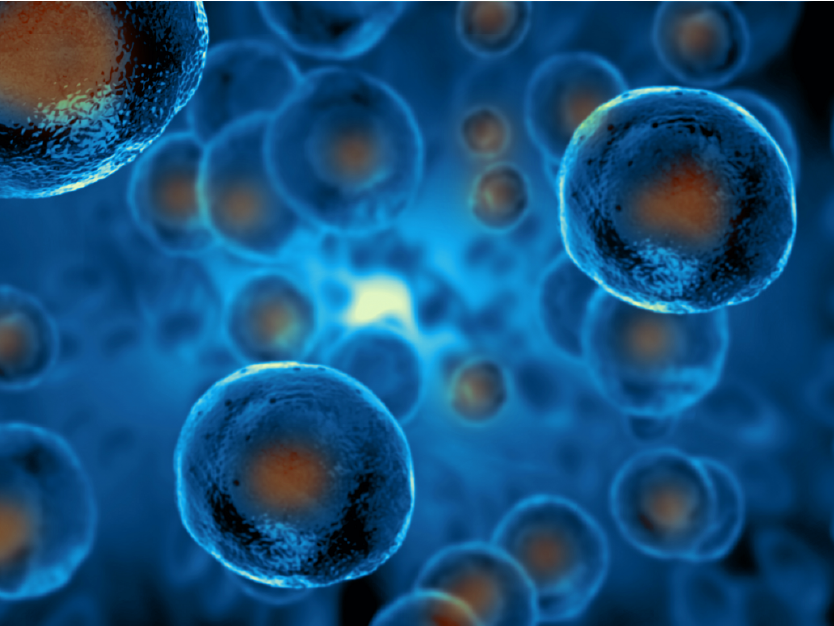A Bird’s Eye View of Necroptosis
Necroptosis is a type of regulated necrotic death driven by defined molecular pathways. Regulated necrosis regulates programmed cell death. Necroptosis is at the center of the pathophysiology of several clinically-relevant disease states, including myocardial infarction and stroke, atherosclerosis, ischemia-reperfusion injury, pancreatitis, and inflammatory bowel disease. Necroptosis results in necrosis-like morphological changes, such as cell swelling, plasma membrane pore formation, and membrane rupture. It also requires co-activation of receptor-interacting protein (RIP) 1 and RIP3 kinases. Necrosome is a complex formed by RIP1, RIP3 and Fas-associated proteins with death domain (FADD). Several studies in the preclinical stage have demonstrated that targeting necrosome can have variable effects on progression of tumors, indicating that it is largely cell-type or context dependent.
The Onset of Necroptosis
Necroptosis, a type of inflammatory programmed cell death, is initiated by extrinsic factors produced by pro-cancer signals and infections. As noted already, the extrinsic factors induce the activation of proteins RIPK1, RIPK3 and substrate MLKL (mixed-lineage kinase domain-like pseudokinase), mostly under conditions when apoptosis cannot be initiated or when apoptosis is inhibited. This leads to cell death by necroptosis. Necroptosis is considered a secondary cell death response and is different from other forms of cell death, like, for example, apoptosis, which can be deemed a more silent fashion of cell death. The necroptotic mode of cell death involves massive inflammation, since the neighboring cells are alerted/disconcerted.
Role of Necroptosis in Development and Disease
Necroptosis is usually stimulated by pro-inflammatory cytokines such as IL-1b and IL-18 in pathological conditions, and therefore they do not have any role in normal developmental stages. RIPK1, RIPK3, and MLKL genes are also not found in primitive organisms. Necroptosis aborts defective embryos during development to ensure healthy, robust offsprings in vertebrates. It can also be activated in the case of acute and chronic diseases, as seen in humans. Activation of RIPK1 and necroptosis has shown efficacy in pre-clinical trials, and was also seen to be efficient in improving the tissue injuries in ischemic brain, kidney, and heart injuries, as well as in multiple sclerosis, ALS, and Alzheimer's disease.
Necroptosis has recently been identified as a key player in the field of cancer immunotherapy. Researchers at the NIH, after conducting an in-vitro study on mice, found that inducing necroptosis in tumor cells could activate the immune system, primarily through cytokine response. They reported that necroptotic cells attract signaling molecules, called cytokines, to the infected cells, thereby mounting an immune response.
The Machinery Behind Necroptosis
Necroptosis is mediated by mixed lineage kinase domain-like pseudokinases (MLKLs). MLKL induces rupture after being translocated to the plasma membrane. Phosphorylation of the activation loop of MLKL by RIPK3 kinase in a multimolecular complex (known as the ‘necrosome') at Ser345, Ser347 and Thr349 brings about conformational change in MLKL, promoting oligomerization of MLKL. The MLKL oligomer then translocates to the plasma membrane. RIPK1 is also an integral part of necroptosis signaling.
Necroptosis is a particularly important mode of cell death and an emerging subject of research. To help support researchers and enable their cutting-edge research, ABclonal offers various necroptosis-related antibody products, as shown in the tables below (click the catalog number to view a specific product page):
Recommended Best-Sellers for Necroptosis Research
|
Category |
Target Name |
Catalog No. |
Product Name |
Applications |
|
TNFR1 and Associated Proteins |
TNFR1 |
TNFR1 Rabbit pAb |
WB, IHC |
|
|
TRADD |
TRADD Rabbit pAb |
WB, IHC, IF |
||
|
TRAF2 |
[KO Validated] TRAF2 Rabbit pAb |
WB, IF, IP |
||
|
CYLD |
CYLD Rabbit pAb |
WB |
||
|
A20 |
TNFAIP3 Rabbit mAb |
WB, IHC |
||
|
[KO Validated] TNFAIP3 Rabbit pAb |
WB |
|||
|
cIAP1 |
BIRC2 Rabbit mAb |
WB, IHC |
||
|
BIRC2 Rabbit pAb |
WB, IF |
|||
|
cIAP2 |
BIRC3 Rabbit pAb |
WB, IF |
||
|
Key Components of Necrosome |
RIPK1 |
RIP Rabbit mAb |
WB |
|
|
RIPK1 Rabbit pAb |
WB, IHC, IF, IP |
|||
|
Phospho-RIPK1-S166 Rabbit pAb |
WB |
|||
|
RIPK3 |
RIP3 Rabbit pAb |
WB, IHC, IF |
||
|
RIPK3 Rabbit pAb |
WB |
|||
|
MLKL |
[KO Validated] MLKL Rabbit mAb |
WB |
||
|
[KO Validated] MLKL Rabbit pAb |
WB, IHC |
|||
|
Relevant Proteins to Necrosome |
FADD |
FADD Rabbit mAb |
WB |
|
|
FLIP |
CFLAR Rabbit pAb |
WB, IHC |
||
|
Caspase 8 |
[KO Validated] Caspase-8 Rabbit mAb |
WB |
||
|
Caspase-8 Rabbit pAb |
WB, IHC, IF |
Recommended ELISA Kits for Necroptosis Research
|
Category |
Target Name |
Catalog No. |
Product Name |
Sensitivity |
Reactivity of Species |
|
Inflammatory Factors |
IL-1 alpha |
Human IL-1 alpha ELISA Kit |
2.54 pg/ml |
7.8-500 pg/ml |
|
|
Mouse IL-1 alpha ELISA Kit |
5.37 pg/mL |
15.6-1000 pg/ml |
|||
|
Rat IL-1 alpha ELISA Kit |
0.45 pg/mL |
15.6-1000 pg/ml |
|||
|
IL-33 |
Human IL-33 ELISA Kit |
5.84 pg/mL |
23.4-1500 pg/ml |
||
|
Mouse IL-33 ELISA Kit |
0.54 pg/mL |
15.6-1000 pg/ml |
|||
|
Rat IL-33 ELISA Kit |
3.0 pg/mL |
7.8-500 pg/mL |
|||
|
HMGB1 |
Human HMGB1 ELISA Kit |
28.3 pg/mL |
62.5-4000 pg/mL |
||
|
Mouse HMGB1 ELISA Kit |
18.29 pg/mL |
46.88-3000 pg/mL |
|||
|
Rat HMGB1 ELISA Kit |
6.7 pg/mL |
15.6-1000 pg/ml |
Conclusion
To sum it up, till date, several studies have demonstrated the composite role of necroptosis and necroptosis-pathway proteins in ameliorating tissue injury. The necroptosis pathway may prove to be an important therapeutic target for various diseases. Several small molecule inhibitors, such as RIPK1-specific necrostatins, have been developed for use in in-vitro studies. ABclonal will continue to provide the necessary services and products to support constantly-evolving research in necroptosis.
References
- Seifert, Lena, and George Miller. “Molecular Pathways: The Necrosome-A Target for Cancer Therapy.” Clinical cancer research: an official journal of the American Association for Cancer Research 23,5 (2017): 1132-1136. doi: 10.1158/1078-0432.CCR-16-0968
- Linkermann, Andreas, and Douglas R Green. “Necroptosis.” The New England journal of medicine 370,5 (2014): 455-65. doi:10.1056/NEJMra1310050
- https://www.cancer.gov/about-cancer/treatment/types/precision-medicine
- Shan, B., Pan, H., Najafov, A., & Yuan, J. (2018). Necroptosis in development and diseases. Genes & development, 32(5-6), 327-340.
- Choi, M. E., Price, D. R., Ryter, S. W., & Choi, A. M. (2019). Necroptosis: a crucial pathogenic mediator of human disease. JCI insight, 4(15).
- Rodriguez, D. A., Weinlich, R., Brown, S., Guy, C., Fitzgerald, P., Dillon, C. P., Oberst, A., Quarato, G., Low, J., Cripps, J. G., Chen, T., & Green, D. R. (2016). Characterization of RIPK3-mediated phosphorylation of the activation loop of MLKL during necroptosis. Cell death and differentiation, 23(1), 76–88. https://doi.org/10.1038/cdd.2015.70
- Khan, Imran, et al. "A decade of cell death studies: Breathing new life into necroptosis." Pharmacology & Therapeutics (2020): 107717.



